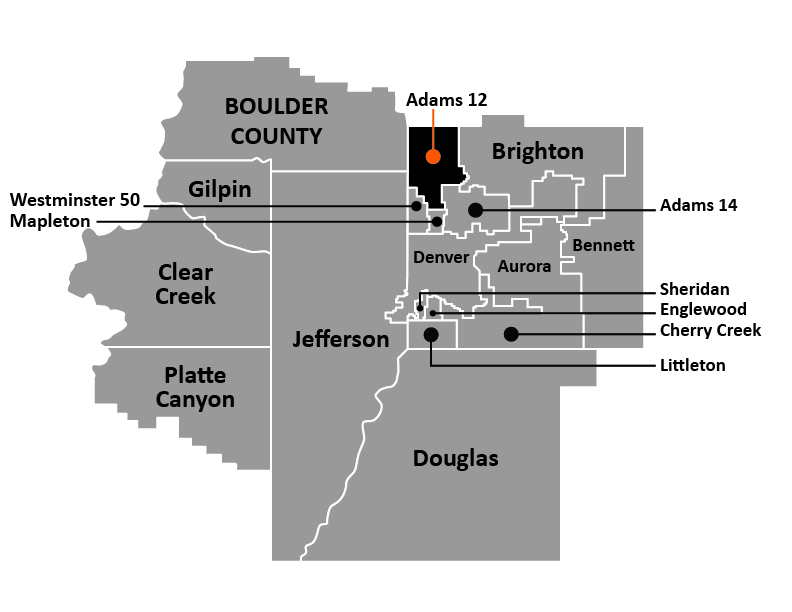You are here
Stories of Promising Practice - Adams 12 Computer Science Story
![]()
Read the Full Story
Quality Schools
Adams 12 Five Star Schools
Computers and computer science have become ubiquitous – intertwined into almost every aspect of our lives, but far too few students are pursuing degrees or careers in computer science.
Adams 12 Five Star Schools is trying to change that. The northern Denver metro area school district of 38,707 students has adopted a computer science curriculum for its secondary school students, created advanced computer science courses and is working on developing computer science lessons for elementary school students.
“Our superintendent (Chris Gdowski) and executive directors saw that there was movement happening all over the nation in computer science and started to see that it was emerging as an area we needed to focus on to help prepare our students for beyond the K-12 environment,” said Anna Otto, the district’s computer science and online learning coordinator.
Colorado is trying to catch up to the demand for more college graduates with degrees in computer science by focusing on the state’s K-12 classrooms – offering teachers free training in computer science, creating rigorous computer science academic standards and developing a passel of educational resources.
Computing occupations are the No. 1 source of all new jobs in the United States and make up over half of all projected new jobs in STEM fields, making computer science one of the most in-demand college degrees. Yet in 2018, Colorado institutions of higher education graduated only 607 students with bachelor’s degrees in computer science.
“In a world that is really run by computers, there really is no industry out there that isn’t impacted in some way by computers,” Otto said. “So whether they decide to be a computer scientist or a programmer or whatever I think that by having that skill or knowledge and understanding of computers will help them no matter what.”
In 2016, the state legislature passed House Bill 16-1198 that required the state to develop voluntary computer science academic standards for secondary students. Content covered in the computer science standards includes computational thinking, computing systems and networks, and computer programming. Additional topics provide students with opportunities to examine the impact technology has on privacy, communication and society. Districts can choose to adopt the standards for their high school students.
Adams 12’s lead computer science teacher Bobbie Bastian was part of a statewide volunteer citizen committee made up of teachers, higher education professors and private sector individuals who helped draft the standards that were adopted by the Colorado State Board of Education in 2018.
Bastian teaches advanced computer science at Adams 12’s Bollman Technical Education Center, where students take courses geared toward specific career pathways.
“When you think about computer science, it’s about computational thinking, taking a problem and being able to deconstruct it or decompose it,” Bastian said. “I think that so many people get wrapped up in coding and it’s not all about the coding. It’s about the problem solving and the creative thinking.”
The school district is expanding its computer science curriculum beyond high school. By the end of the year, the district expects to have curriculum for five middle school courses and for grades three through five. By next year, it expects to have curriculum for kindergarten through second grade. The district has worked with MindSpark and the Colorado School of Mines to provide elementary school teachers with tools and resources to explore ways to integrate computer science into other contents, especially at schools without computer science. Additionally, high school students from Bastian’s classes visit elementary schools to teach younger students some computer science basics. The district is also working to diversify the classes by encouraging more females and minorities to consider computer science pathways.
“Finding a way to include females and underrepresented groups in computer science is a challenge that everyone is grappling with,” Otto said. “One of the things that we are trying to do is have specific opportunities geared directly at females to start with, more collaborative opportunities and looking at more hands-on opportunities.”
Having exposure to computer science in early grades may encourage students from diverse backgrounds to continue with the pathway as they get into high school, Bastian said.
“The goal is to get computer science into the younger grades to keep that opting out from happening,” she said. “They can see that they can be successful and then they’ll choose to stay in versus just opting out because they have no idea what it is.”
To encourage more educators to learn how to teach computer science, the state has offered teachers grants for professional development. The Colorado School of Mines partnered with the Colorado Department of Education to offer free training sessions on computer science for elementary school teachers.
Additionally, another grant opportunity allows for district-determined professional development for elementary-level teachers, in which Local Education Providers can choose the provider(s) best suited for their needs to train teachers. Districts can apply for grants up to $30,000 under the Elementary District Determined category.
The state also created a Computer Science Resource Bank with a wide variety of ideas for teachers on how to teach the subject, including sample curricula and materials – even information about scholarships for students.
Bastian provides professional development training for teachers around the state. She encourages schools to look at the secondary standards, work in computer science pathways for their high schoolers and begin teaching some of the key concepts of computer science to younger students. She also encourages teachers and districts to look into the grants that are available for professional development.
For more information on the computer standards, please visit this webpage.





Connect With Us




